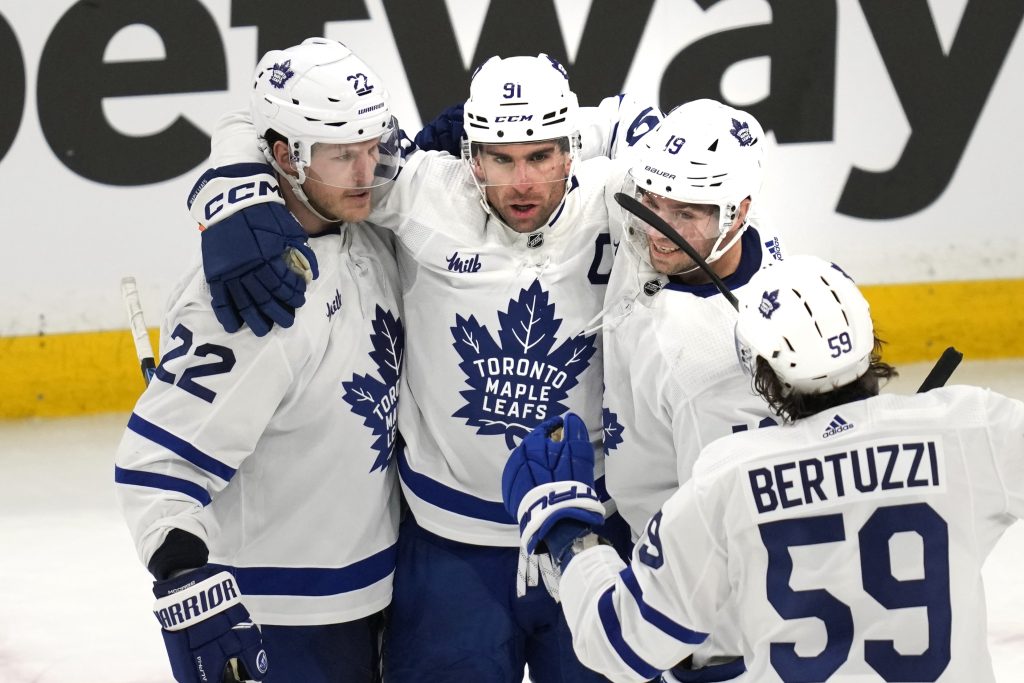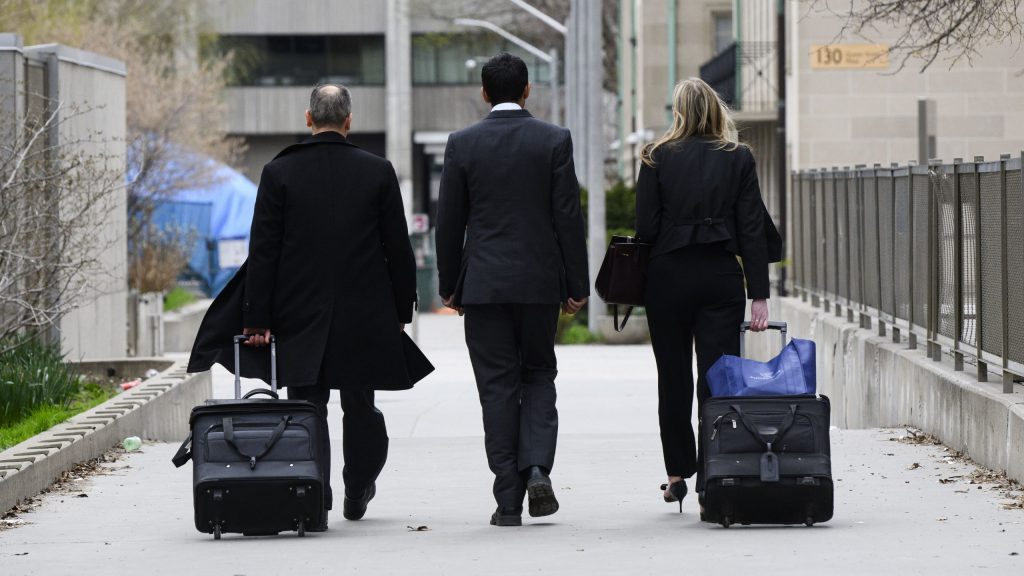Leafs’ rebuild testing fans’ patience
Posted March 9, 2012 2:13 pm.
This article is more than 5 years old.
Months before Leafs Nation turned white in the knuckle and blue in the face — the result of repeated cries for change that, in one sense, at least, were heeded — Willie Mitchell had a much different look on his mug during a trip to Toronto.
If the L.A. Kings defenceman was visiting the crumbling Centre of the Hockey Loony-verse today, he’d notice nobody is exactly effusive in their praise of Toronto Maple Leafs management.
But when Mitchell’s team skated through just before Christmas, he couldn’t help but reflect positively on his relationship with Leafs senior vice-president of hockey operations Dave Nonis.
“He’s in the players’ corner, all the time,” says Mitchell of Nonis, a fellow B.C. native who once inked him to play for the Canucks.
“He’ll defend his players to the bitter end. Those are the people you want to play for, those are the people you have respect for and want to give that little extra for. Burkie’s not stupid. That’s a big reason he brought him out East.”
‘Burkie,’ of course, is Brian Burke, the man who, as GM of the Maple Leafs, directs the management team Nonis is a part of. Burke arrived in the city early in the winter of 2008 with the stated mandate of turning around hockey’s most popular franchise in a fashion that wouldn’t require an extended rebuild.
The fact he was only 17 months removed from lifting the Stanley Cup in Anaheim when he landed in Toronto was just one reason fans and some members of the punditry believed he could make good on his promise.
But more than three years later, the Leafs are teetering toward a seventh consecutive season outside the playoffs — the previous franchise record for futility was three — thanks largely to a February meltdown that cost former coach Ron Wilson his job and threatens to completely torpedo what was otherwise shaping up to be a season of progress.
The hue and cry from Leafs supporters across Canada was deafening after Burke allowed the trade deadline to pass without making the kind of bold move that has defined his career and the noise was only slightly tempered when, after witnessing Wilson completely lose the team and hearing the Air Canada Centre faithful chanting “Fire Wilson,” he relieved his old college hockey teammate of his duties and replaced him with another man he knows well, Randy Carlyle.
A year that was supposed to be about slow-and-steady strides has disintegrated into another circus, just one more disappointment in a seemingly endless string of ineptitude. But lost in hyperbole and hand-wringing is the fact Burke, Nonis and the rest of a beefed-up Toronto front office serve as a microcosm for the franchise as a whole, an organization that’s finally focused on accruing the assets required for sustainable, ground-up success, as opposed to searching for quick fixes.
Though he was deemed not yet ready to be coach of the Maple Leafs when the switch was made, Dallas Eakins is more than qualified to talk about the Leafs’ current state compared to what greeted Burke upon his arrival. The Toronto Marlies coach is in his third season running the bench on the farm and has held a number of positions within the organization dating back to 2005.
At that point, a much smaller hockey operations department was being helmed by John Ferguson Jr., who some would argue was never given the green light from ownership to put his scouting background fully to use and build the Leafs from the ground up. Exactly how and why the organization became bereft of players who could step up and challenge for an NHL roster spot is a moot point now, but the bottom line is there wasn’t nearly enough internal competition for jobs, and the trickle-up effect was a very thin, fallible team. “I won’t name names — and this is before Brian Burke — but there were players playing for the Toronto Maple Leafs who were just there by default,” Eakins says.
Not all the players Burke has brought in to fill that void have worked out, especially those he acquired early in his tenure. In his first summer on the job, Burke inked defencemen Mike Komisarek and François Beauchemin to very regrettable contracts.
Then, in the fall of 2009, Burke made the kind of splash Leafs-lovers were hoping for, shipping two first-round picks and a second-rounder to Boston for ultra-talented right winger Phil Kessel, who was just about to turn 22. The trade blew up in Toronto’s face when the team conked out in the 2009–10 season and handed the B’s — a division rival, no less — the opportunity to draft Tyler Seguin second overall in 2010, then nab the highly touted Dougie Hamilton ninth overall last June.
To be sure, Kessel has become a feared sniper, but Seguin, still just 20, is developing into the kind of two-way centre the Leafs have been starved for since Mats Sundin rode off into the Swedish sunset by way of Vancouver. Hamilton is a six-foot-four Niagara IceDogs blueliner who, despite missing a chunk of the season to play for Canada at the World Junior Hockey Championship, will almost surely lead all Ontario Hockey League defencemen in scoring.
Jared Knight, the oft-forgotten third asset in the deal, is winding down a respectable career for the OHL’s London Knights, in which he’s been a little better than a point-per-game winger the past two seasons. All this is to say it’s a damn good thing Kessel can skate and shoot the puck the way he can, because if he couldn’t, the transaction that brought him to Toronto would go from tempered tragedy to unmitigated disaster.
Those terms might also be in line with how some observers would characterize coach Ron Wilson’s time in Toronto, or at least the final stages of it. The often sardonic coach had his testy back-and-forths with the media, the tone of those encounters intensified by the stress of too many losses. But it should be noted the 56-year-old sits sixth on the all-time coaching wins list and most of the W’s he was able to earn in three-plus playoff-less seasons in Toronto came without the benefit of highly capable charges. It’s now on Carlyle, Burke’s bench boss when Anaheim won the ’07 championship, to leverage his gruff, direct style into better results for a group often prone to being defensively scattered.
How the coaching change will play out remains to be seen, but it sure stands a chance of joining the list of quality moves Burke has made. Early in 2010, he jettisoned a barge of riff-raff to Calgary in exchange for Dion Phaneuf, now the team’s captain, and young defenceman Keith Aulie, who was subsequently flipped for big forward prospect Carter Ashton in one of two minor-league deals Burke made on deadline day 2012.
A year after acquiring Phaneuf, Burke swapped Beauchemin, who never played nearly as well in Toronto as he did in Anaheim, back to the Ducks for Joffrey Lupul and Jake Gardiner. The former, at age 28, has found his game, at last, after a series of trades and debilitating injuries. Gardiner, meanwhile, is a story unto himself. The 21-year-old’s all-world skating, decision-making abilities and poise sometimes make him look like he’s already realized his tantalizing long-term potential.
“He carries himself like he’s been in the league 10 years,” Eakins says.
Burke also took some of the sting out of the Kessel deal when he moved defenceman Tomas Kaberle — who one year later became completely untradeable — to Boston before last year’s deadline in exchange for six-foot-five pivot Joe Colborne, along with first- and second-round picks from the Bruins.
It’s hard to say exactly what impact Colborne and fellow prospect Nazem Kadri will have at the NHL level, but both earned American Hockey League player-of-the-month honours earlier this season and have contributed to a top-rate Marlies team that’s also benefited from the development of young players like forwards Matt Frattin and Marcel Mueller, as well as D-men Jesse Blacker and Korbinian Holzer.
Even players fans are less familiar with, such as gritty forwards Ryan Hamilton and Greg Scott, are helping improve the situation, as their edgy approach and desire to play for the big club makes everyone around them better. “That competition between each other, from the top to the bottom, has elevated everyone’s play because they’re kind of looking over their shoulders all the time,” Eakins says.
Fans may have been clamouring for some of the aforementioned names to be included in a package for Columbus Blue Jackets stud right winger Rick Nash, but that would have required the Leafs to gut much of the desperately needed organizational depth they’ve worked hard to build. The fact that Nash remained in Columbus is a clear indication the Jackets asked for the moon in return for their franchise player. Burke could have provided that, and Nash would have felt right at home in Toronto, not because he’s from nearby Brampton, but because the Leafs’ supporting cast would have looked a bit like the lowly Blue Jackets’, had the Leafs given up all that was required to get him.
Restraint might not stoke the fires of the ticket-buying public, but it’s not a bad characteristic to have for a group of ultra-competitive men trying to run a hockey club. And each member of that sizeable team of suits brings his own attributes.
Nonis has followed a path very similar to Burke, working in the league office and spending time on the West Coast as Vancouver’s GM, taking over from Burke in 2004 when he parted ways with the Canucks. Former Philadelphia Flyers captain Dave Poulin scouted for Burke with the Ducks and is now Toronto’s vice-president of hockey operations.
Assistant GM Claude Loiselle has also worked for the NHL office, while senior advisor Cliff Fletcher has spent a lifetime in the game dating back to his days scouting for the Montreal Canadiens in the ’50s. Rick Dudley joined the Leafs’ front office as director of player personnel last summer and, though his stints as GM in previous stops haven’t been wildly successful, he’s universally recognized as a man who can spot talent.
Burke’s direct, high-volume approach gives the air of someone who values his own voice well above that of any other. But if a GM — or any person in a position of power, for that matter — wasn’t going to lean on the opinions of others, why would he surround himself with qualified people? According to Poulin, when it comes to rigid plans and schedules, his work environment is as loose as Burke’s tie at a media scrum. “We’re not a formal, 8 a.m.–meeting group,” he says. “We’re a constant conversation group.”
In keeping with the over-arching theme of fluidity, Poulin said nobody’s responsibilities are written in stone, but he has the most day-to-day interaction with the Marlies, Dudley takes in the most NHL games that don’t involve the Leafs, and Loiselle, as the point man on contract negotiations, is a big reason the team is in good long-term shape salary cap–wise. Fletcher, who was inducted into the Hockey Hall of Fame in 2004, serves as an all-purpose sounding board.
Because of their extensive professional history together, Burke and Nonis have their own dynamic within the group. The bottom line is that no matter where or when a meeting of the minds occurs, once the door closes and the theories start flying, there’s enough insight to make more good decisions than bad. “The amount of opinions when you start talking about a player, it’s not just, ‘I see it this way and that guy sees it that way,’” Eakins says. “This is a conversation, sometimes, between eight [or] nine people about one player. You can really get down to the nuts and bolts, whereas if there are only two or three people talking, maybe you don’t get that in-depth.”
And conversations are by no means limited to current co-workers. The network established by those who have been in the game a long time helps fill a black book with people who might provide a golden nugget. “You’re able to get a lot of information on a lot of different players and get a real clear, clear view from a whole bunch of different contacts outside of your organization because of your relationships with these people,” Eakins says.
Though there might not be a lot of direct contact between players and management, Mitchell believes there’s a top-down tone set when competent people are running the ship. “Teams take the character of their leaders all the time, so when you have good leaders at the top like Burkie and Noni, you’re going to be in good shape,” he says. “Good people, but demanding. As players, you want someone who will tell you how it is when they need to because they’re in that position [of authority].”
The Leafs are in a position to help the league tremendously if they can become a team that once again makes the playoffs and is capable of winning a round or two.
The Buds’ unconditional popularity was obviously a huge factor in Rogers Communications — which owns this publication — and BCE putting their differences aside and entering into a partnership to buy a 79.5 percent share of Maple Leaf Sports and Entertainment this past December. It’s almost overwhelming to contemplate how many additional people would emerge from the woodwork to root for, and against, the NHL’s most polarizing outfit if it went on a deep post-season run.
Profits from nationally broadcast games — unlike deals for regional rights — go to the NHL and are divvied up among the league’s 30 clubs. (Canadian teams get a slightly higher cut from games involving clubs from north of the 49th.) Revenue from jersey sales occurring in team stores at or around Air Canada Center are funnelled directly to the Leafs bank, but when a department store anywhere in the continent outfits a fan in blue and white, that dough goes back to the league, with each club claiming a share. For that reason, the sheer volume of interest Toronto can drum up makes it economically appealing from a number of perspectives for Burke’s boys to be in the mix.
“The fact of the matter is, the Maple Leafs having success has the capability of generating a lot more money — on top of what they do generate — than other teams having success,” says Kurt Badenhausen at Forbes.
Burke landed in Toronto with a ton of clout, but he’s now on the clock. His contract expires July 1, 2014, according to a source in the organization, and he’s already played one major hand by making a coaching change. As the years left on his contract wane, there’s still a ton of work to be done. But haste has never served any team well — especially one that’s going on nearly 50 years without a championship — and there’s no point in becoming shortsighted now. “We’re trying to win, but we’re not going to do it at the expense of the organization,” says Poulin. “We’re going to build this long term.”
Until things change, expect the already-rampant swell of fan angst to keep building, too.










